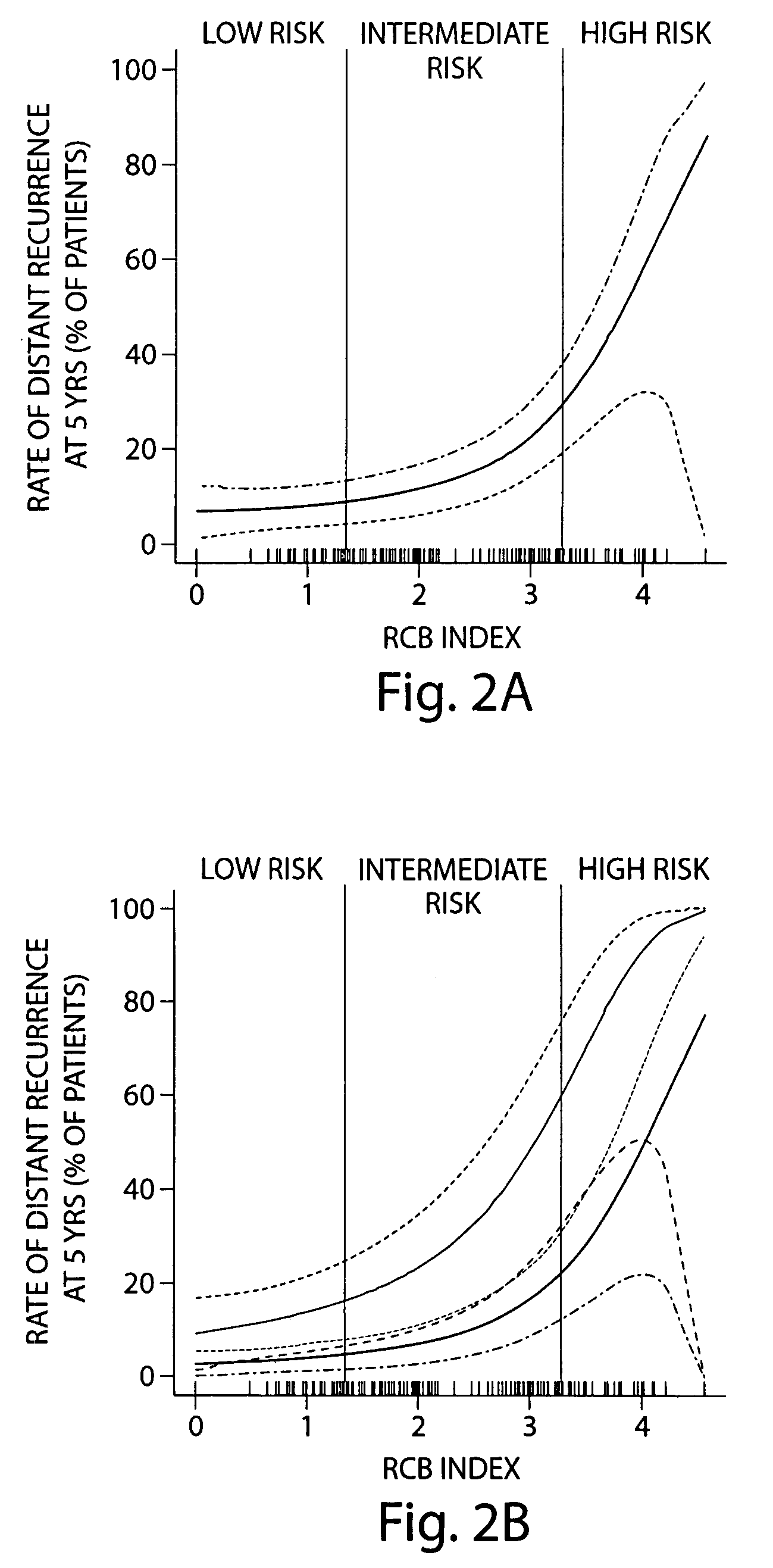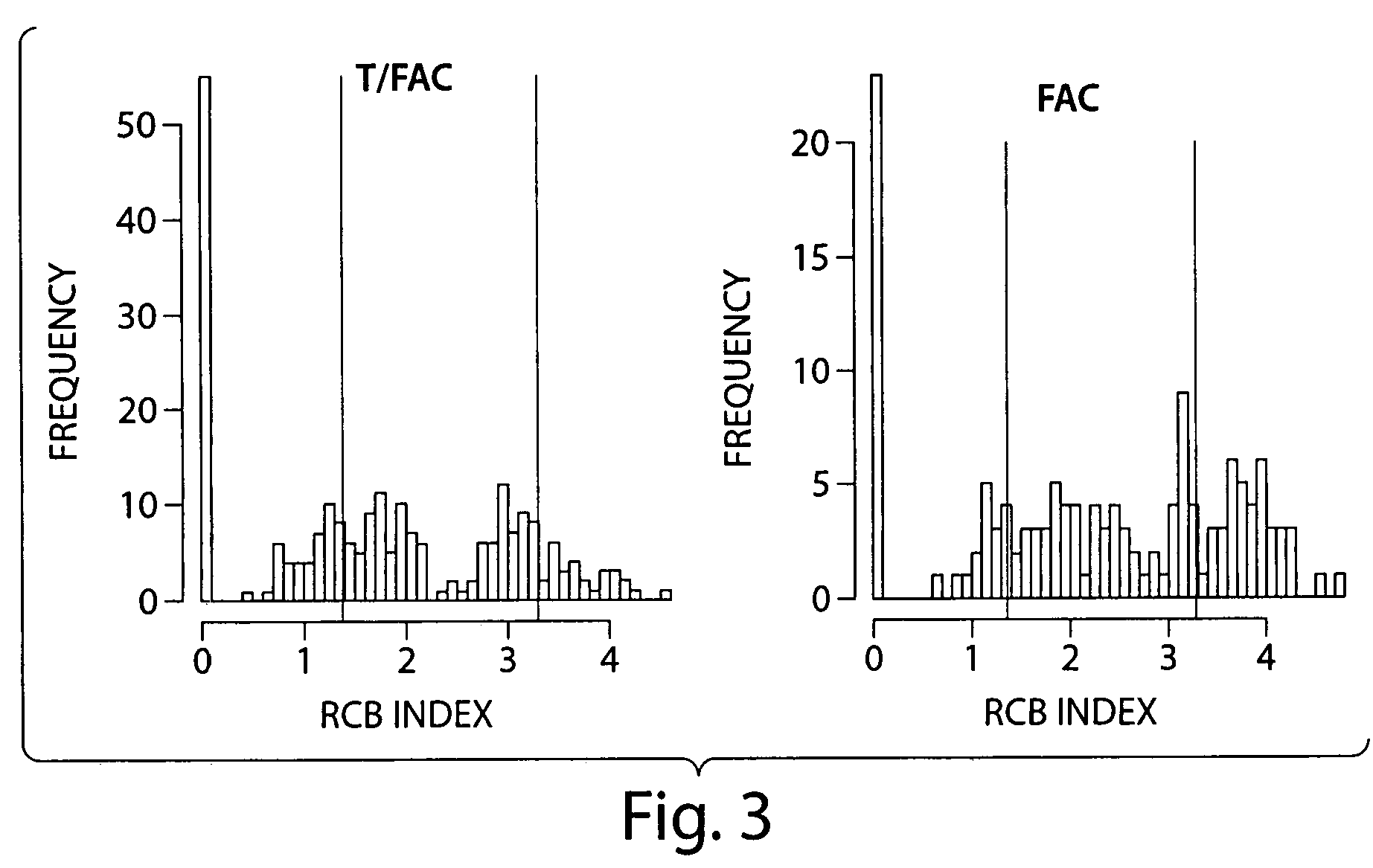Method of measuring residual cancer and predicting patient survival
a residual cancer and patient technology, applied in the field of assessing the response of patients to antitumor treatment, can solve the problem of uniform definition of pcr and achieve the effect of improving patient outcom
- Summary
- Abstract
- Description
- Claims
- Application Information
AI Technical Summary
Benefits of technology
Problems solved by technology
Method used
Image
Examples
example 1
General Methods
Patients and Materials
[0071]Pathology reports and hematoxylin and eosin (H&E) stained slides were reviewed from the surgical resection specimens of 382 patients who completed neoadjuvant chemotherapy for noninflammatory, invasive breast carcinoma (T1-3, N0-1, M0). One cohort included 241 patients who received six months of neoadjuvant chemotherapy with a regimen including paclitaxel, 5-fluorouracil, doxorubicin, and cyclophosphamide (T / FAC) followed by surgical resection of the residual tumor with negative margins and either sentinel lymph node biopsy procedure or axillary dissection (protocol MDACC DM 98-240) (Green et al., 2005). Patients in this trial were randomized to receive preoperative chemotherapy consisting of paclitaxel (T) given at 3-weekly intervals (225 mg / m2) or weekly for 12 cycles (150 mg / m2 for node positive patients or 80 mg / m2 for node negative patients) (Green et al., 2005). The paclitaxel courses were followed by four cycles of FAC (5-fluorouraci...
example 2
Definition of Risk Groups Based on Cut-Point Analysis
[0083]Response to neoadjuvant chemotherapy is an intermediate endpoint for breast cancer relapse and survival. The most commonly used systems for breast cancer response classify response as complete pathologic response (pCR) and residual disease. The RCB index, which includes pathologic assessment of both the primary breast tumor and of the regional lymph nodes, can provide a basis for further classification of residual disease in prognostic categories.
[0084]By design of the RCB index, RCB=0 scores correspond to complete pathologic response. It is clear from FIG. 2B that subjects with high levels of residual disease (e.g. RCB score>˜3) after neoadjuvant T / FAC chemotherapy have a considerably higher risk of disease relapse and therefore poor long-term prognosis. Furthermore, another subgroup of patients with low levels of residual disease (e.g. 0<RCB<˜2) are associated with very low risk of disease relapse, with similar prognosis a...
example 3
RCB Classification Versus Clinical Parameters for Predicting Distant Relapse
[0091]Patient age, tumor stage, chemotherapy regimen, and pathologic response status were independent predictors of distant relapse in a multivariate Cox regression model that included clinical and treatment covariates but did not include RCB index as a predictor (Tables 3 and 4). When the RCB index was included, age (P=0.01) and chemotherapy regimen (P=0.03) were still significantly associated with relapse risk, but the clinical stage before treatment and the binary pathologic response (pCR vs. RD) were not. The RCB index was significantly associated with the risk of disease recurrence, even after adjusting for the additional covariates (HR: 2.50, 95% CI: 1.70-3.69, P<0.001 for TFAC cohort) (Table 3), and it improved significantly the overall predictive power of the multivariate Cox model (P<0.001). It has been recommended that the predictive ability of a new marker should be evaluated based on whether the ...
PUM
| Property | Measurement | Unit |
|---|---|---|
| size | aaaaa | aaaaa |
| diameters | aaaaa | aaaaa |
| diameter | aaaaa | aaaaa |
Abstract
Description
Claims
Application Information
 Login to View More
Login to View More - R&D
- Intellectual Property
- Life Sciences
- Materials
- Tech Scout
- Unparalleled Data Quality
- Higher Quality Content
- 60% Fewer Hallucinations
Browse by: Latest US Patents, China's latest patents, Technical Efficacy Thesaurus, Application Domain, Technology Topic, Popular Technical Reports.
© 2025 PatSnap. All rights reserved.Legal|Privacy policy|Modern Slavery Act Transparency Statement|Sitemap|About US| Contact US: help@patsnap.com



